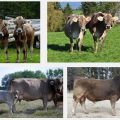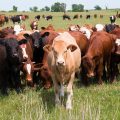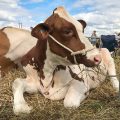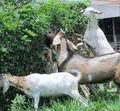Backyard cattle fattening has gained popularity as an important business project of the livestock industry in the Philippines. Raising cattle in the backyard gives the farmer year-round work and provides him with extra income.

How to Raise Cattle
Types of Cattle Raising
1. Cow-Calf Operation
2. Breeder Farm Operation
3. Growing-Fattening Operation
Cow-calf Operation
Cows and bulls are raised to produce calves in this type of operation. Calves are then raised until they are weaned from their dams at seven to eight months of age. After weaning, they can be sold immediately, or raised for a few more months for use as replacement stocks or sold for fattening.
The cow-calf operation is considered most challenging because the producer needs to be familiar with the reproductive
phenomena, as well as the breeding and feeding systems. He should also be knowledgeable on the management practices involved in the production and maintenance of cows, bulls, and calves. A good animal health program should also be observed to minimize mortality and ensure the productivity of the animals.
Breeder Farm Operation
The main interest of the raisers is to produce animals for breeding purposes. Thus, the calves are raised until they are ready for breeding, provided they passed the selection criteria.
Since the main output of a breeder farm is quality breeding animals, a large herd is necessary for the selection of the replacement stocks. Purebred animals are usually utilized in this project. The breeder farm can be maintained in the ranch, in complete confinement, or integrated with plantation and forest trees. The farm requires a number of animal stock, a big farm, and a big capital.
Growing-Fattening Operation
Growing-fattening operation is the most popular type of cattle raising in the Philippines. It requires simple facilities and level of management. The project is also shorter and the return of investment is relatively higher than the cow-calf operation.
Growing cattle can be raised through grazing or cut-and-carry feeding. Thus, it needs little capital so it can be managed by small-hold cattle raisers.
On the other hand, the fattening or finishing stage is usually done intensively or in confinement. The animals are kept within an area so that the feeds given to them are utilized to develop their tissues.

Guide in Selecting Stocks Based on Physical Appearance
Selecting Cows and Heifers for Breeding
Milking ability and feminity
Mild maternal face with bright and alert eyes, good disposition, and quiet temperament.
An udder of good size and shape. An udder that is soft, flexible, and spongy to the touch, not fleshlike and hard, is expected to secrete more milk.
Age
In general, beef cows remain productive for 13 years if they start calving at three years of age. They are most productive from four to eight years of age.
Breeding ability and ancestry
Cows that calve regularly are desirable. Calves from cows that do not take on flesh readily do not give much profit. In buying heifers for foundation stock, select those which belong to families which have regularly produced outstanding calves.
Types and conformation
An ideal cow has a rectangular frame. Should be of medium width between the thurls and pins to have necessary frame on which to hang profitable beef. The rump must be long and smooth.
Selecting a Bull
Physical appearance
A fairly good middle or barrel indicates a well-developed digestive system and healthy vital organs such as the heart, liver, and lungs. Likewise, a full heart girth, broad muzzle, large nostrils, muscular checks and jaw, well-rounded thighs, and a full loin, make up a good constitution. A bull with these qualities is desirable.
The legs of a bull should be strong enough to carry its own weight and to carry him around to look for cows that are in heat and to search for food when necessary. Successful mating of cows is insured when a bull has strong legs.
Sex character
Well-developed sex organs are characterized by fully descended testicles, deep wide chest, and broad head. These qualities indicate virility and good reproduction.
Selecting Cattle for Fattening
Age
Young animals have striking advantages over older cattle. They need less feed for every unit gain in weight because they can masticate and ruminate thoroughly and can consume more feed in proportion to their body weight. Their increase in weight is due partly to the growth of muscles and vital organs. In older cattle the increase is largely due to fat deposits.
On the other hand, older animals as feeder stock also have advantages. Generally, a two-year old steer will require a shorter feeding period than a calf or a yearling because the latter grows while it fattens. Calves are choosy when given coarse and stemmy roughage, while two-year old steers utilize large quantities of roughage to produce fat primarily because they have a better capacity to digest. In most cases, they readily relish the feeds ordinarily rejected by the calves.
Disposition
An active yet mild, quiet, and easily-handled steer usually grows fast and fattens easily. Restless, nervous, and erratic cattle waste too much energy when they panic even at the slightest provocation.
Constitution and vigor
These are determined by the size and quality of the vital organs. A large feeding capacity, strong appetite; a large heart girth; well-sprung ribs; and a wide, deep, and full chest show good constitution and vigor.
Sex
Generally, more steers than heifers are available for fattening because some heifers must be retained as herd replacements. If fed for the same period of time, steers gain about 10 percent faster than heifers and require 10 to 15 percent less feeds with equal weight gain. On the other hand, young bulls have 20 percent greater gain in live-weight and require 22 percent less feed to produce a leaner carcass which is nearly of the same quality as
that of steers.
Health considerations
A healthy animal is active and has a soft and smooth hair-coat. The eyes are bright and the muzzle is usually moist. Special attention should be given to unsoundness and defects in conformation when selecting feeders. Animals that are blind, lame, or with crooked legs should be avoided. Those with rough skin and evidence of ectoparasite should also be avoided.
Feeding Management Practices
Feed animals daily with concentrate one to two kilograms per day during fattening period. Give roughage daily at 3% of body weight if given air dry or 14% if given fresh.
Give clean water without limit or ad libitum. Provide ordinary table salt about 30-50 grams per head per day.
Give the animals fresh, palatable feed and clean water at all times. Reduction of feed intake by 5 percent will reduce weight gain by 10 percent. Do not overstock feeds in the feedbunk since the bottom portion will develop heat and make the feed stale.
Mix feed properly. Have at least 15-20 percent roughage in feed to prevent bloat and other digestive disorders.
During rainy days, cattle will eat more during the daytime. During summer, they will eat more at night and during the cooler hours. Provide enough feeds during these periods.
Digestion will be more efficient if roughage is eaten separately from concentrates. Roughage consumption tends to stimulate saliva secretion up to as much as 80-120 liters per day.
Providing 12-14 inches of bunk space per head will allow cattle to eat slowly.
Schedule manure removal. If allowed to remain with the animals, deep, wet manure will reduce both feed intake and weight gain.
Management of Calves, Growers, and Fatteners
Calves
Calves should suckle colostrum milk from their mother within three hours after calving. A calf that has not suckled five to six hours after calving should be led to his mother’s udder. During bad weathers, weak calves should be taken to the barn with the mother. However, orphaned calves may be raised to cow’s milk or milk replacers. Calves should be given concentrates at an early age for faster growth.
Growers
Growers are weaned yearlings which are not to be fattened immediately. They are handled in such a way that maximum growth is achieved at the lowest possible cost. The growing period starts from weaning to fattening or replacement stage. Growers are usually maintained in the pasture with very little attention; they are given salt and mineral supplements. If raised in confinement, concentrates should be given in addition to grass or roughage.
Fatteners
Fatteners require a shorter period to reach slaughter weight. They are generally bigger, mature, or nearing maturity. However, one and a half to two year-old animals weighing 200 to 300 kg are preferred. They may be fattened either in feedlot, on pasture, or in both areas.
Cattle Housing System
Proper housing is important in successful cattle fattening operation. Adequately protect animals against the adverse effects of weather when they are raised in relatively small areas. Animals in backyard cattle farms are usually tethered along roadsides and in backyards during the day and confined in a shed or corral at night. The permanent type of housing consisting of GI roofing, timber frames, concrete floor, feed trough and water troughs are used in most farms. The shelter is open-sided and is located near the farmer’s house or under the shade trees. Building height ranges from 1.79 to 1.9 meters while the width varies from 2.1 to 2.7 meters. Each animal can be allocated with 1.5 to 4.5 sq. meters.
A fenced loafing area beside the goat house must be provided (100 to 150 sqm/250 head), complete with feeding racks and water troughs to allow animals to loaf freely. Flooring of the area must be cemented to facilitate drying. Cogon and nipa as roof materials are preferred in hot and humid areas.
Ventilation is of outmost importance. Majority of pneumonia cases can be traced to excessively warm and humid interior and sudden changes in temperature. Allow a 0.5 to 1 feet clearance between floor to wall and wall to beam to create an adequate circulation and to lower draft. It is desirable to maintain an interior temperature of 28 to 30°C. It has been established that above 30°C ruminants are inhibited from eating.
Lighting may also be provided in the barns during the night. Goats consume up to 30% of the day’s intake during the night when light is provided.
Other Options:
Cow-Calf Operation
Cow-calf operation in small-hold farms is usually done using simple methods and facilities. The animals are usually tethered during the day and kept inside the shed during the night. The shed is built from native materials like wood and bamboo for frames and enclosures; nipa and cogon for roofings. Feeding and watering troughs can also be made out of locally available materials such as used tires, used and halved drums. The shed is usually built near the house of the farmer.
Fattening Operation
In this type of operation, the animals are raised in individual stalls with a space about 1.5 m x 4 m/head. Each stall can accommodate one animal during the entire fattening period. The shed is built three meters high to allow good ventilation. Bamboo, lumber, or ipil-ipil poles can be used for frames; nipa or cogon for roofing materials although galvanized iron roofing may be used for durability.
Concrete and sand should be used as flooring to prevent mud from accumulating. This will facilitate cleaning.
Marketing
Current marketing system of beef cattle is now becoming efficient especially in areas where there is a livestock auction market.
However, a number of middlemen are still involved in the system, thus creating a little complex marketing channel. In areas where there is no livestock auction market, the usual channel of distribution is set up in this order: barrio agents, shippers, Manila-based buyers, and meat retailers.
Marketing efficiency can be improved by reducing the number of stages in market channels. This can done by encouraging direct selling from producers to butcher-retailers or processors.
Some marketing tips:
– Be aware of the current market price of livestock.
– Do not let buyers into your herd and do their picking. Select marketable animals and let the buyers choose from them.
– Sell your animals on a per-weight basis rather than on a per head basis.
– Dispose all marketable animals readily. There is no advantage in keeping disposable animals. They will just compete with other fatteners and feeders for available feed supply and other facilities on the farm.
– Do not market sick animals.
Sources: bar.gov.ph, DA–ATI







Great article. However, please edit that Cattle Housing System. Thanks
nice one…. no need to work abroad.
thanks for this article its very useful.
mmmmp
This article is truly useful, succinctly gives you the information you need for starting up.
informative..
Great article! If you invest in an adult cattle today, how many years will it take for the investment to return?